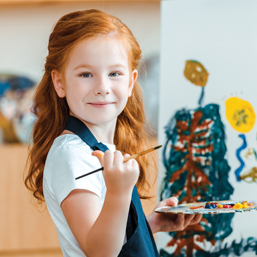
Remember your first coloring book... the first time someone mentioned, “you need to stay within the lines, sweetie” or mentioned with surprise, “oh, I didn’t know that trees were pink!” We nurture arty children from day one to try to fit in to conform to what we consider correct. We subconsciously nudge children to discover what is normal - all in pursuit of possibly having a child prodigy artist in the family.
If I may, I’d like to test you a bit to step outside your comfort zone, as I ask you the question: do you have unconscious biases about children and art? Young artists need some direction as they explore. However, we need to be careful to equip them with only a backpack and a walking stick instead of a clearly paved path leading to familiar destinations!
The top four mistakes I see adults make are:
1. Stop giving children instruction or advice unless you are an established artist.
If a child asks for feedback on their art, ask them three things:
“What do you like about your picture/painting/sculpture?”
“What do you think is missing?”
“Who would you talk to or where would you go to find the answer?” (to the second question)
You do not have permission to tell a child that something is ‘wrong’ with their work unless you are willing to guide them on how to fix it and you are willing to take responsibility for the lack of confidence you will instil in them in that split second when you criticize their work. I’m not asking you to be soft with them, art is tough - it’s political and competitive. The time will come when they have the skills and grit to deal with that side of art. Grade 5 art class is not that time.
2. Avoid comparing a child’s work to others (their friends’, their siblings’, or an established artist’s work) unless, of course, the goal is to raise a fine art forger. Every artist learns new techniques by trying something that is completely unique. It is okay to copy others to learn something new, but it is a dangerous habit to compare emerging work to others. There is enough room in this world for a new technique and new style from every budding new painter. Give them the space to try something new without the weird stress of knowing they are being compared to someone else in your eyes.
3. Lock up the credit card and do not buy expensive art supplies unless a child brokers a deal with you (first born or first masterpiece). I understand you think it might encourage them to paint more. I know many kids that stopped painting as soon as their parents bought them supplies. It is the expectation and commitment that comes with the supplies. It can be unbearable for a child.
Imagine the true commitment to explore when a child earns their own money and buys the supplies they want to work with. Letting them save up also teaches them an early lesson on calculating the return on investment (ROI) of a painting if they decide to be a professional artist one day.
4. Art is supposed to be fun and serious. If you want your child to improve, provide opportunities for them to learn in many different ways.
In addition to art at school, be sure to explore:
Whether you think you have a child prodigy painter in your family or have a cool niece or nephew who asks you to color, don’t be afraid to take it one step further to support them. Just remember, they are on a unique journey and you can supply them with some tools, but you can’t tell them which path to take.
Shannon has been creating and selling art since she was 13. She was recently featured on the Canadian Energy Centre site for her series on Reclamation to help educate a new audience on responsible environmental management and reclamation in the energy industry. Check out her online gallery, Whiskey Jack Gallery, at shannoncarlaking.com.
Calgary’s Child Magazine © 2024 Calgary’s Child